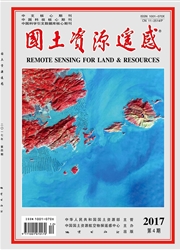

 中文摘要:
中文摘要:
将雷达遥感技术应用于滑坡灾害调查是地学应用的一个重要方向,特别是在多云多雨地区。由中国科学院电子学研究所研发的高效能机载SAR系统( high-performance airborne synthetic aperture Radar system,HASARS)具备X波段双基线干涉和P波段全极化观测的能力,是国内首家多频段多模式机载SAR系统。从多极化机载SAR数据的特征选择和信息提取等角度,评估了不同极化模式组合对滑坡信息提取精度的影响;并基于Bayes决策理论,提出了多极化SAR图像分类的特征选择方法。利用不同研究样区的特征选择结果提取了多个滑坡的范围,提取精度均在90%以上。 HASARS的高空间分辨率及其获取的高精度DEM和P波段全极化观测,可以近实时、高精度地获取地表滑坡灾害专题信息,在滑坡等减灾救灾领域具有广阔的应用前景。
 英文摘要:
英文摘要:
The application of the Radar remote sensing data to landslide investigation is of great importance, especially in cloudy and rainy areas. The high-performance airborne synthetic aperture Radar system( HASARS) developed by Institute of Electronics,Chinese Academy of Sciences,is the first home-made system characterized by multi-band and multi-mode,which has the capability of interferometric survey of X band and double antennas as well as polarimetric observation of P band. In this paper, the accuracies of landslide information extraction from polarimetric SAR data using different polarization combinations were investigated to evaluate the technology, methodology and implementation ideas of the landslide applications with the HASARS, and the focuses included two aspects: the methods of information extraction and the ways to select the feature. The results show that, based on Bayes decision theory and using the samples of landslide and non -landslide in the image to analyze and make decision, the method of feature selection could make classification of polarimetric SAR image satisfactorily. Based on the results of feature selection, the authors extracted the landslide regions from SAR images with supervised classification methods, with their accuracies higher than 90%. The airborne SAR system, with high spatial resolution, high precision DEM production and P band polarimetric observations, can obtain the thematic information of landslide surface more flexibly and precisely, and hence it has a broad prospect in the landslide disaster relief applications.
 同期刊论文项目
同期刊论文项目
 同项目期刊论文
同项目期刊论文
 期刊信息
期刊信息
